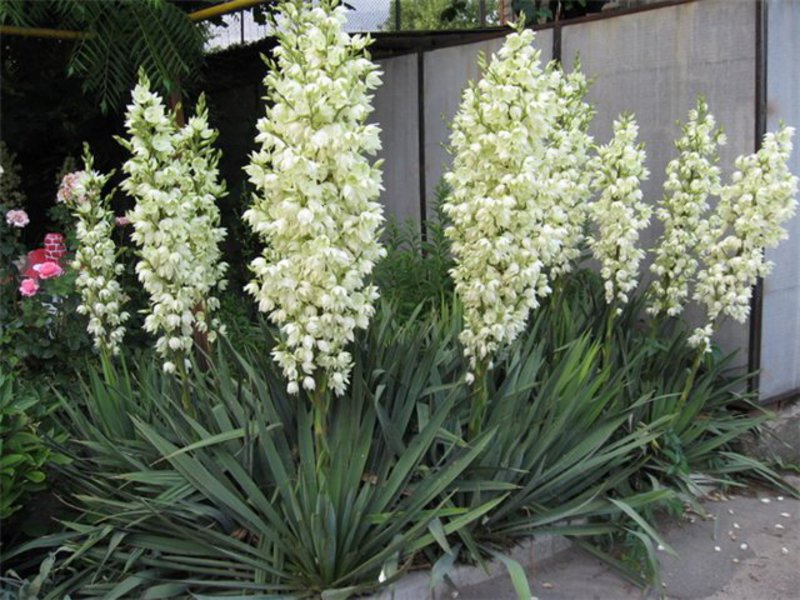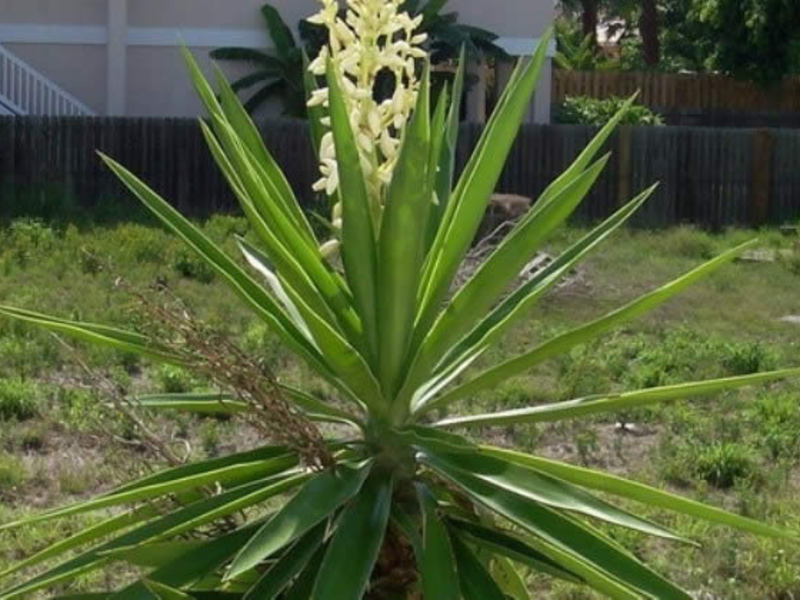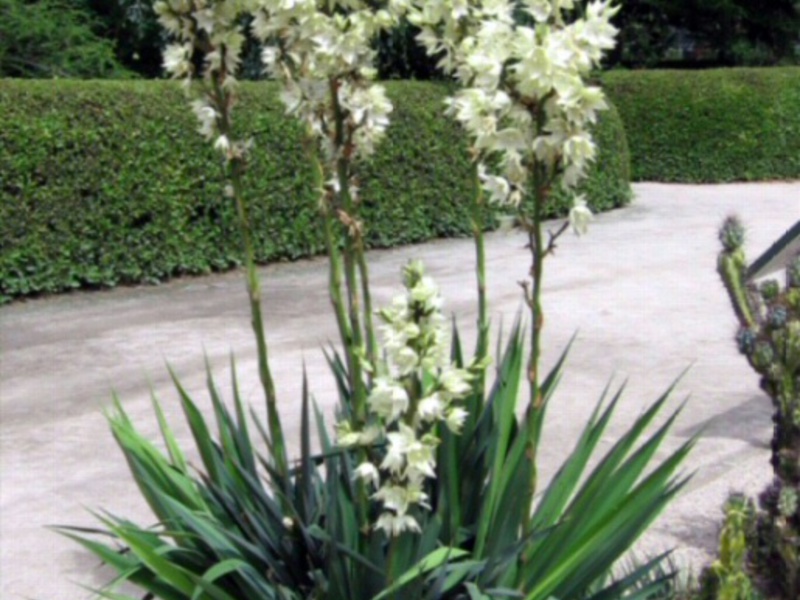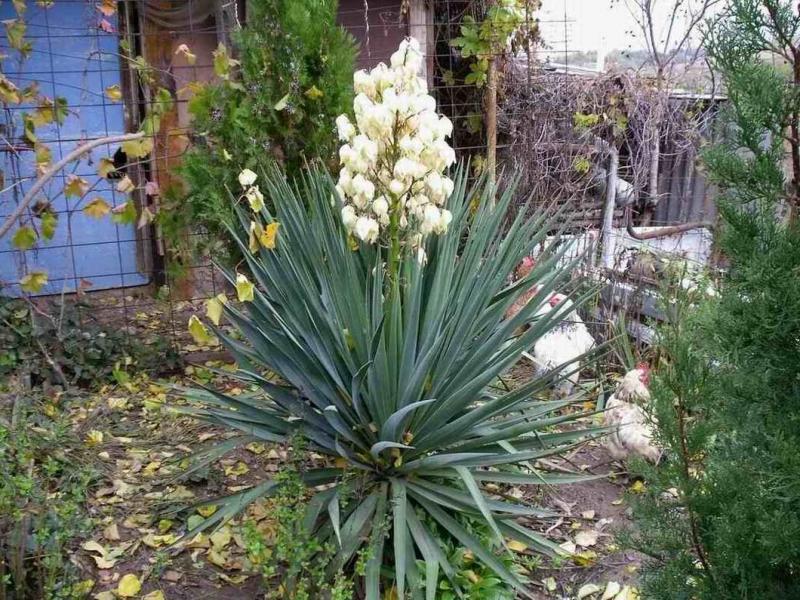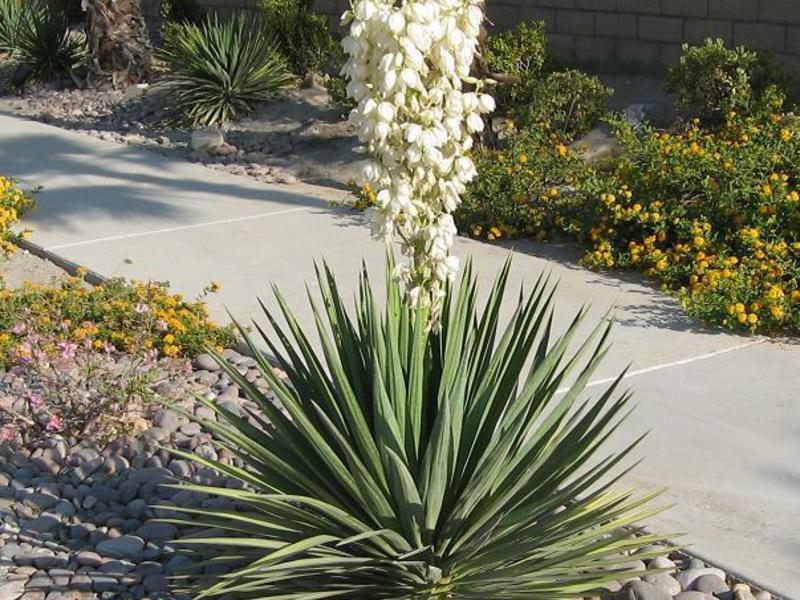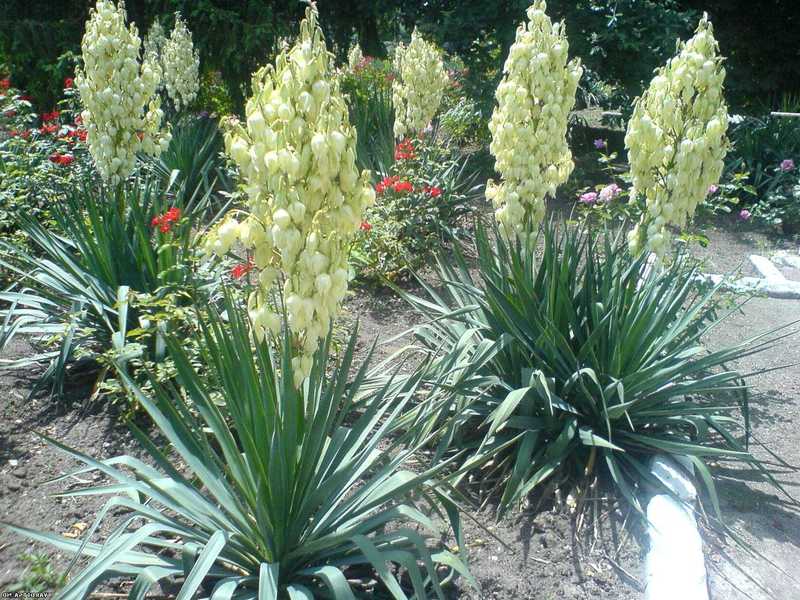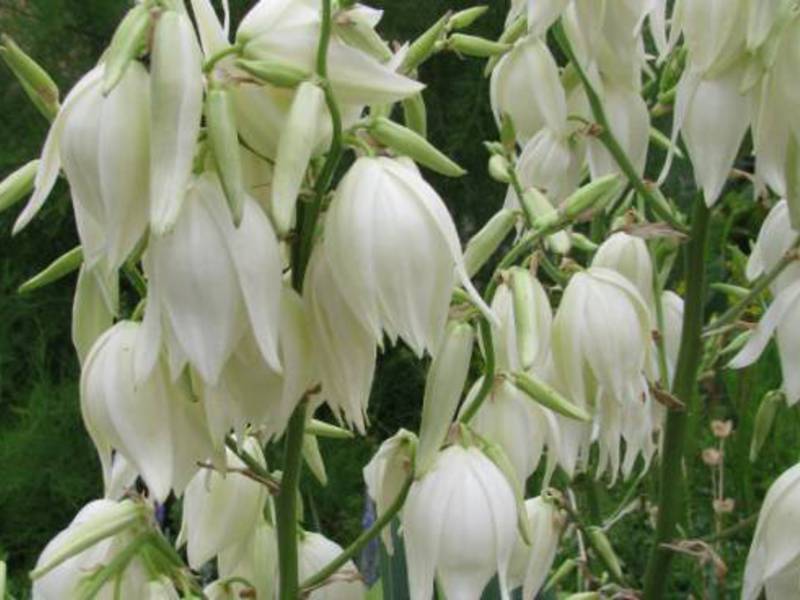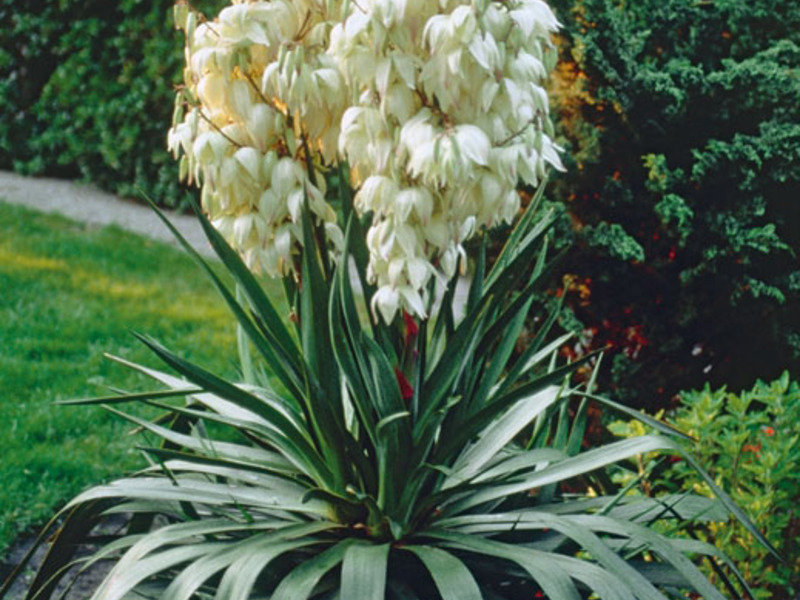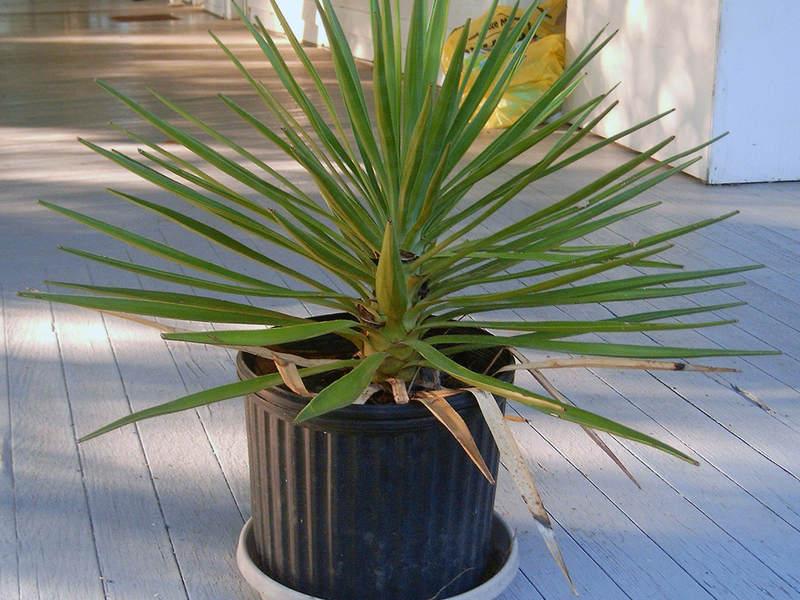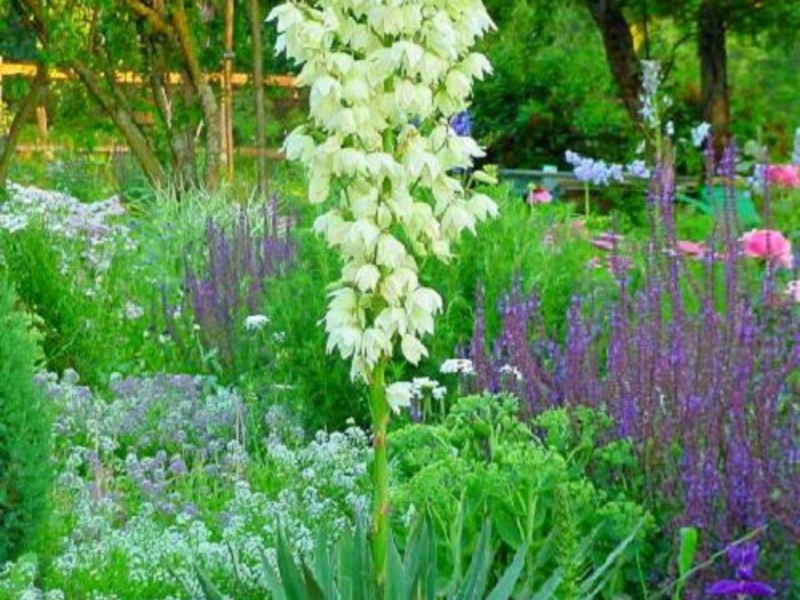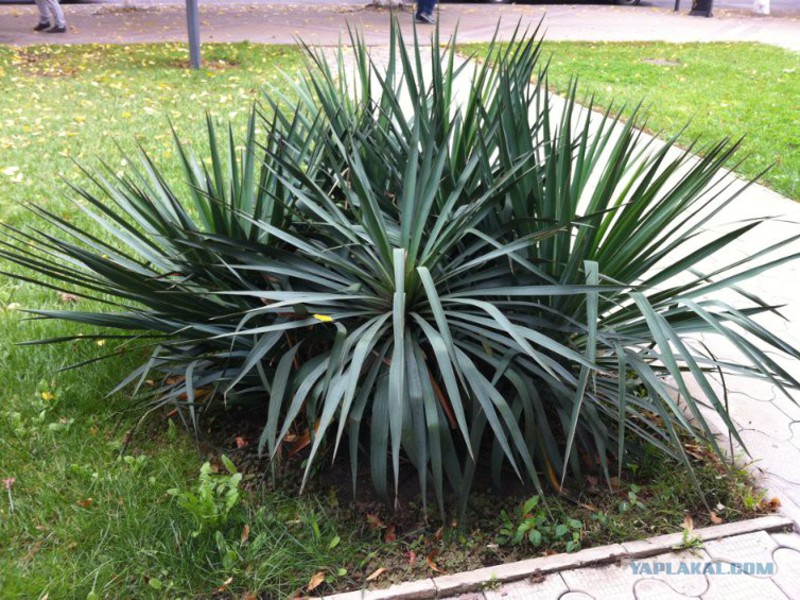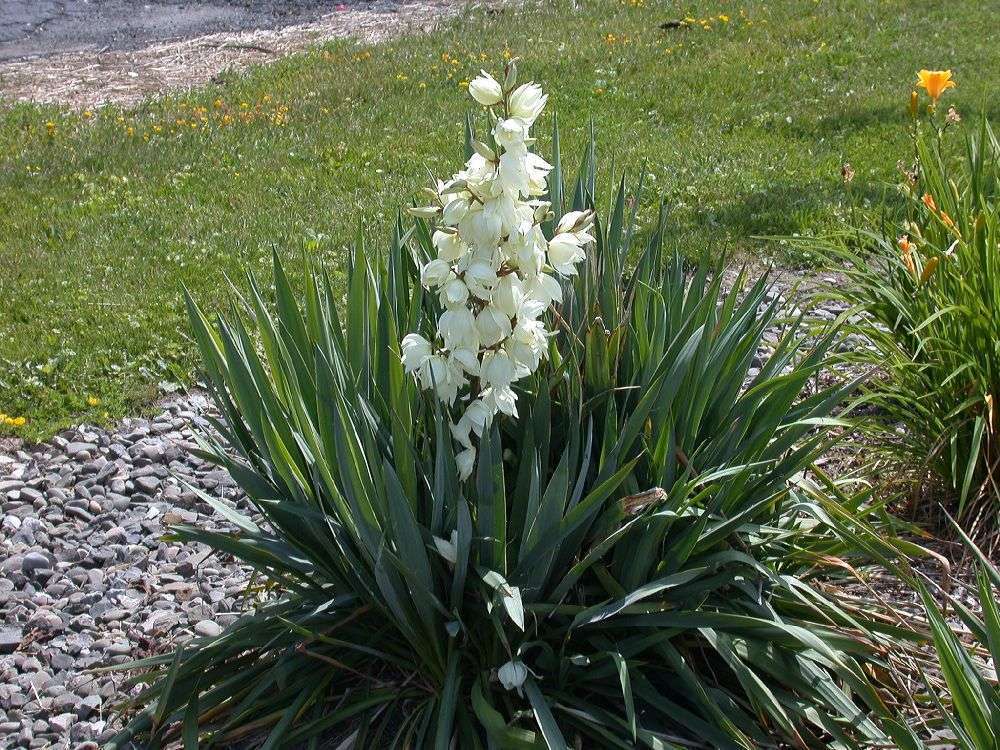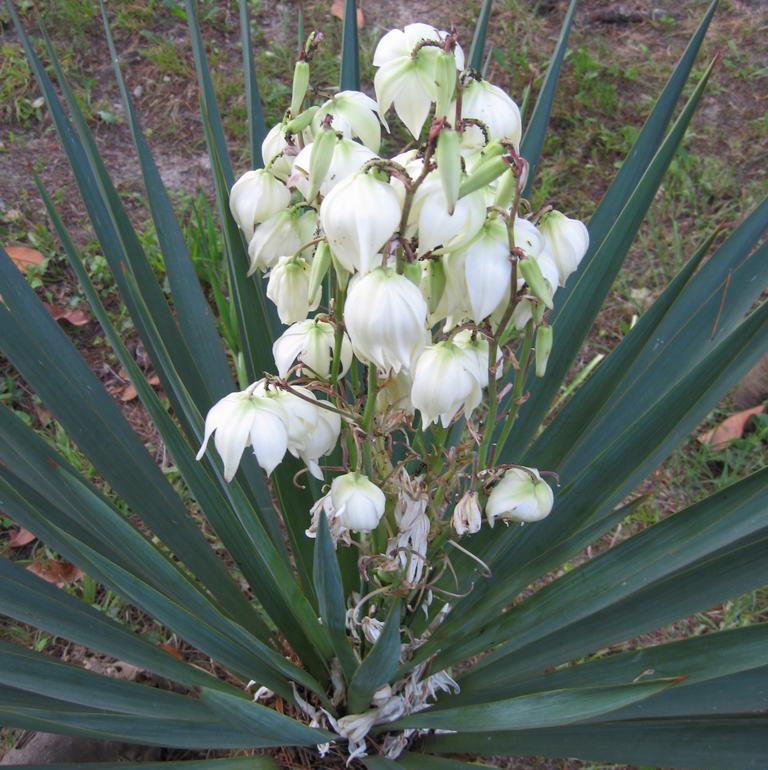Exotic plants have attracted gardeners throughout the years. One of the brightest representatives of the class of evergreens is yucca... This plant, which belongs to the agave family, is native to the humid subtropics of North America. This requires the owner to create similar conditions: the climate must be dry and hot. However, not everyone has the necessary knowledge about the rules for caring for this plant at home, the features of reproduction, etc.
Content
Appearance
This plant may have single or branched stem... Also, yucca differs from other plants in that the leaves cover not only the branches, but also the trunk. They are slightly elongated and form a pointed shape at the end. Throughout its life, yucca blooms very rarely. Its flowers are large enough and have a white tint. Many people associate them with bells because of their original shape. Many gardeners choose this plant not to enjoy their flowering, but to enjoy its unusual appearance. After all, yucca strongly resembles a miniature palm tree.
Choosing a place for a plant
 If you are going to grow yucca in pots, it is recommended to install them on a window located on the south side. In this case, it is undesirable that direct sunlight falls on the flower. In the absence of a bright spot, yucca can be placed in partial shadewhere she will also feel good. However, do not count on the formation of a lush green crown.
If you are going to grow yucca in pots, it is recommended to install them on a window located on the south side. In this case, it is undesirable that direct sunlight falls on the flower. In the absence of a bright spot, yucca can be placed in partial shadewhere she will also feel good. However, do not count on the formation of a lush green crown.
With the onset of summer, it is recommended to take the flower out to the balcony or it can be transported to the country house, where it should find a place on the street. Here the yucca will receive the maximum amount of light. Caring for the plant is simple, but at first it does not hurt to get acquainted with the peculiarities of planting this plant.
I would like to repeat once again that yucca is a light-loving plant. Therefore, in the room where it is grown, it is necessary to maintain a fairly high temperature. This flower reacts with active growth if the temperature in the summer is within + 20 + 25 degrees Celsius... With the onset of winter, it is recommended to transfer the plant to a darkened place, where the temperature should be maintained within + 10-12 degrees. It is important to ensure that there are no sudden changes in temperature at this time of the year, even though the plant will be dormant at this time. If the air temperature in the room drops below critical levels, the plant will not be ready for this and will die.
Watering and spraying
Watering is one of the important measures that determines how strong and healthy the plants are. Yucca is not very demanding on moisture, so frequent watering can harm it. Be sure to take care that on the soil surface the water did not stagnate for a long time... She also does not feel better if left without moisture for a long time.In winter, it is watered much less frequently. Watering once a week is usually sufficient to meet water needs.
Spraying plants is useful in the summer, which must be done very carefully. While the leaves are moistened, care must be taken to protect them from sunlight. Otherwise, it will lead to burns. It is also important to avoid water entering the leaf rosettes and between the trunks of nearby plants during the operation. In winter, the leaves are sprayed more often than in summer, since at this time the level of humidity in the room decreases. This measure is effective if the procedure is carried out in winter at least once a day.
When growing any plants at home, caring for them involves feeding... And yucca is no exception. It is best to plan fertilization during the warm season, when plants are entering the stage of active growth. Top dressing will not be beneficial if applied to the soil too often. Usually it is enough to carry out this operation every two to three weeks. You can improve the quality of the soil by adding manure, humus or peat to it. The best effect can be achieved if special agave fertilizers are used in the process of plant care.
Planting
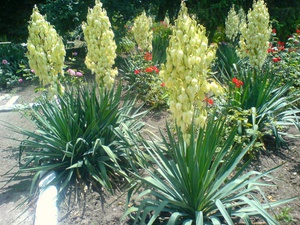 There are several ways in which you can propagate yucca at home.
There are several ways in which you can propagate yucca at home.
- Pieces of trunk 15 cm long;
- Cut off and rooted tops;
- Daughter sockets.
As a substrate where the planting material will root, you can use sand or mixture based on sand and peat... When the material is ready, the plant must be planted in a pot, having previously filled it with a soil substrate, which must contain pieces of charcoal. Also, drainage must be provided in the container, which can be used as pieces of rubble or broken shards. The latter are best suited because of their lower weight. Also, many gardeners grow yucca from seeds.
Propagation of yucca by a top cut
When the gardener has the first mature yucca bush, it can be used for breeding at home. It should be borne in mind that it must be a flower with a height of at least 30 cm.One of the possible propagation methods for the yucca palm is use of cuttingtaken from the top.
- for harvesting, the branch must be cut off with a sharp knife or blade. Do not harvest too much planting material - the plant will feel worse if it has few green leaves;
- after harvesting the cuttings, the cut points must be lubricated with crushed coal. After waiting a little, you can subsequently see how new branches begin to grow from the healed wound. As a result, such a manipulation allows you to get a spectacular branched yucca;
- after harvesting the cuttings, you must give them time to dry. This usually takes about two hours. Then they need to be placed in wet sand. Until the time comes for transplanting the plants to a permanent place, they must be kept moist. To do this, the top can be placed in a glass of water, after adding activated carbon to it. Even before rooting, individual leaves may die. This moment must be monitored and removed. When the root system has developed well enough, you can transplant the plant into a pot.
Reproduction by a piece of a trunk
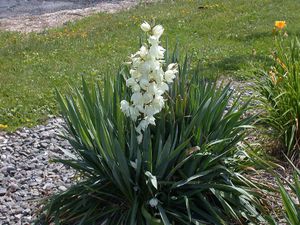 The operational method of breeding yuki is using pieces of the barrel... This method is more suitable for those gardeners who have already repeatedly propagated this flower. First you need to very carefully cut off a section of the trunk and place it in the wet sand. This should be done in such a way that the planting material is horizontal.By keeping the sand wet, you will soon be able to see the roots and buds begin to form on the handle. As a result, this method will allow you to get some new yucca seedlings.
The operational method of breeding yuki is using pieces of the barrel... This method is more suitable for those gardeners who have already repeatedly propagated this flower. First you need to very carefully cut off a section of the trunk and place it in the wet sand. This should be done in such a way that the planting material is horizontal.By keeping the sand wet, you will soon be able to see the roots and buds begin to form on the handle. As a result, this method will allow you to get some new yucca seedlings.
Reproduction at home by offspring
The offspring that this flower can often produce can also act as a good planting material. First you need find a suitable container, which is filled with wet sand. Then it is necessary to carefully separate the offspring and place it in the soil substrate, fixing it vertically. After some time, a small tree will grow out of it, which subsequently needs to be very carefully looked after. Therefore, you will have to prepare a pot filled with oily garden soil for replanting.
Pruning plants
The benefit of pruning is that it allows you to form a lush and branched plant crown. To do this, you will have to remove part of the top of the bush - about 10 cm. The place of cut must be treated with crushed coal or garden pitch. A similar operation can only be carried out on those palms that have been able to root well and have reached a height of 60 cm.
Yucca transplant
In order for a flower to grow well after transplantation, it needs not only proper care, but also a high-quality soil mixture. To do this, you need garden soil, to which you need to add sand in the amount of 1/3 of the volume of the prepared mixture. To the bottom of the pot stack broken shards, and a piece of permeable geotextile is placed on top. After that, the container is filled with earth, but only up to half the volume. Having completed the basic preparations, they proceed directly to the palm transplant.
 try to leave as much old soil as possible on the roots of the bush during the operation.
try to leave as much old soil as possible on the roots of the bush during the operation.- take any available tool and pry the plant so that it can be easily transferred to the prepared pot;
- then a lump with roots needs to be pressed down a little to the surface, and from above it should be covered with the rest of the unused soil mixture;
- at the end, the soil in the root zone must be well tamped.
Plant diseases
Yuka is no different from other horticultural crops, so she needs to be provided with appropriate care. Deterioration in the condition of the palm can be observed as a result of damage fungal or bacterial infections... This can be determined by the appearance of dark spots on the leaves. Subsequently, in the absence of measures, this can lead to softening of the tissues and their decay. In some cases, this process can affect part of the trunk.
In this state, care will involve removing the affected areas with a sharp knife. The same must be done for damaged leaves. The parts of the yucca bush that are not affected by the disease should be treated with a systemic fungicide. During this period, it is necessary to reduce the frequency of watering. The same diseases can also affect plants grown in indoor conditions. In this case, you need to take care of them in a similar way.
Yucca is resistant to many insect pests. However, the greatest danger for her is spider mitewhich she can contract in hot weather. To combat it, it is recommended to use a weak solution of tobacco tincture, which needs to be sprayed on the trunk and leaves.
Conclusion
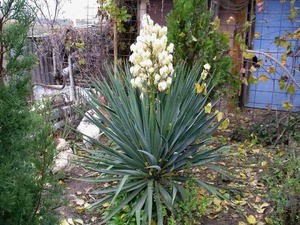 Although yucca rarely pleases with its flowering, many gardeners are interested in it for its unusual decorative appearance. Therefore, many who had the opportunity to enjoy the view of this plant are often set to plant it on their site. This is quite simple to do if you follow the agrotechnics of growing yucca.
Although yucca rarely pleases with its flowering, many gardeners are interested in it for its unusual decorative appearance. Therefore, many who had the opportunity to enjoy the view of this plant are often set to plant it on their site. This is quite simple to do if you follow the agrotechnics of growing yucca.
Home care is equally important. Special attention needs to be paid preparation of potting mix, since before the moment of transplanting the yucca to a new place, optimal conditions must be created for its growth. Also, success in this matter largely depends on the correctly selected planting material.It is best to use cuttings, which root well in most cases and develop into a strong, healthy plant.
